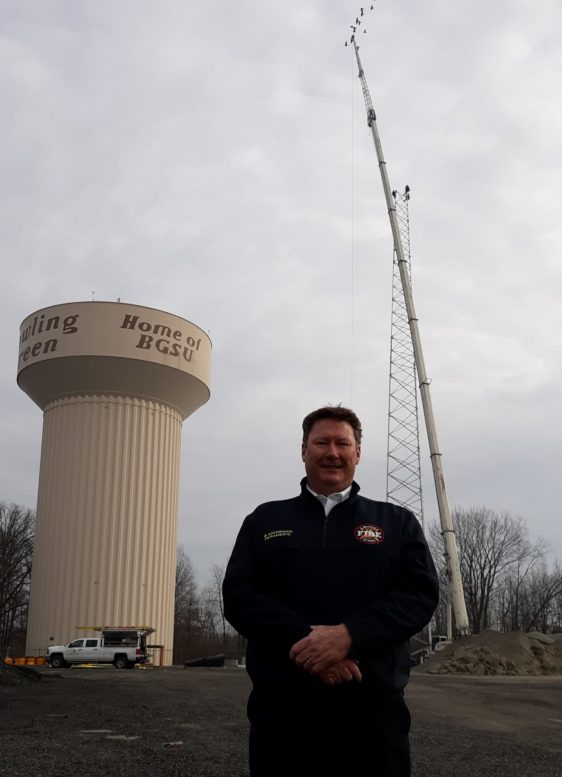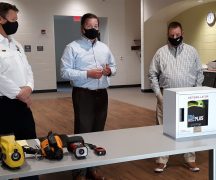By JAN LARSON McLAUGHLIN
BG Independent News
As the top section of the 300-foot tower hung in mid-air, Bowling Green Fire Chief Bill Moorman watched in anticipation.
“This is the last piece of the puzzle,” Moorman said Thursday afternoon as the MARCS radio tower was erected at the Ohio Department of Transportation site on Mitchell Road.
The puzzle has been the radio dead zone in Bowling Green – locations where emergency responders could not communicate with others.
There are times when firefighters or paramedics are inside large buildings at Bowling Green State University, manufacturing sites or downtown, that they are unable to have radio contact with those outside the buildings.
“It’s a dangerous situation,” Moorman said in 2020 when the city was awarded $500,000 in the state capital budget for the construction of a MARCS radio tower.
MARCS – the Multi-Agency Radio Communication System – is Ohio’s wireless, digital communication network for first responders that enables local, state and federal agencies to communicate with each other.
More than 2,300 public safety/public service agencies use MARCS.
The need for a different first responder communication system in Ohio surfaced during the 1990 Shadyside flood and the 1993 Lucasville Prison riot. Gaping holes in communication with the existing radio systems became apparent. So the Ohio General Assembly authorized the development of MARCS.
Until now, the closest MARCS towers to Bowling Green were located in Bradner, Neapolis and Toledo – which left a hole in the radio communications systems here.
Moorman has been looking forward to sealing up that gap.
“This is a great day for public safety,” the chief said as the top of the tower neared completion.
“The tower will make for a great reliable system. That way we can all communicate with each other,” the chief said. “Right now it’s fragmented.”
All the surrounding fire departments in Wood County are already using MARCS for radio communication.
“This is going to make things safer for everybody in the county using MARCS,” since it will strengthen their radios as well, Moorman said.
“It’s going to improve the safety for all first responders in and around Bowling Green,” he said. “And everyone who lives and commutes here.”
While the Ohio State Patrol uses MARCS, many local law enforcement agencies use VHF radio communication.
But with the new tower, Bowling Green Police Division will be switching over to the MARCS system soon, according to Lt. Adam Skaff, who said several of the new radios are sitting in his office in preparation for the shift.
By switching to the MARCS system, the police will have direct contact with more emergency responders, such as Ohio State Patrol. Currently, if the state patrol has a pursuit on Interstate 75 near Bowling Green, the information has to be relayed through the patrol dispatchers to the police dispatchers, then to the officers.
“We’ll now have direct contact with OSP” on a specific “pursuit channel,” Skaff said.
Wood County Emergency Management Agency and the Ohio Department of Transportation are already on the MARCS system. And Bowling Green State University Police Department is in the process of transitioning to MARCS.
Switching over is not cheap, with the city budgeting $350,000 to buy new radios for police officers and vehicles.
The police and fire divisions will no longer be responsible for the radio system infrastructure, which will be maintained by the state.
Wood County Sheriff Mark Wasylyshyn said last year that his office will not be switching over to MARCS.
“Not with the way MARCS is run,” Wasylyshyn said, noting that there is no representation of sheriff’s offices on the MARCS board.
For some, the expense of MARCS is a detriment. The radios are twice as expensive as VHF radios, plus user and subscriber fees are charged, the sheriff said.
The dispatchers at the sheriff’s office have radios that allow them to communicate with first responders on MARCS, and the sheriff’s patrol vehicles all have portables on MARCS.
Bowling Green Municipal Administrator Lori Tretter said the shift to MARCS will benefit local businesses that otherwise may have had to invest in antennae to improve radio communication for fire services.
“This will save businesses money and help with a community solution,” she said.
Tretter also pointed out that the police radios being replaced had reached the end of their lifespan.
“The timing of this tower is great for everybody,” Moorman said.
“It’s a regional approach, too,” Tretter said. “So we can be ready for everything.”
The new tower is located next to the city’s water tower on Mitchell Road, on a site that previously housed an ODOT tower.





